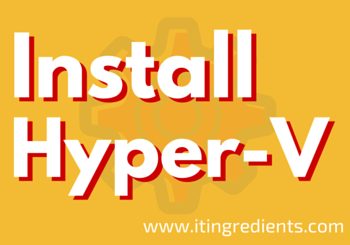How to install Hyper-V in Windows Server 2012 R2
How to Install Hyper-V in Windows Server 2012 R2
Hyper-V is a role of Windows Server Operating System which is used to create virtual machines. All virtual machines include an operating system, storage, and other devices like a physical server. Hyper-V is like a platform or a Hypervisor layer between physical and virtual machines. All virual machines use the resources of a physical server via Hypervisor layer. Virtual machines will utilize the physical resoures of a computer in a best possible manner. It also reduces the cost of physical servers, as virtual machines can be used instead. In this post we’ll learn the steps to install Hyper-v in Windows Server 2012 R2.
Steps to install Hyper-V in Windows Server 2012 R2.
If you are planning to install Hyper-V in your lab i.e. planning to install Hyper-V on VMWare Workstation then follow the steps given in “How to enable Nested Hyper-V on VMWare Workstation“. By default Nested Virtualization is not enabled. This article would help you in enabling Nested Virtualization. Once the Nested Virtualization is enable, we can start with the steps to install Hyper-V in Windows Server 2012 R2.
1. To install Hyper-V, open Server Manager and click on “Add roles and features” to install the role of Hyper-V.
2. On “Add Roles and Features Wizard” console will explain us about the importance of roles and features wizard. It also reminds us to verify some necessary tasks to be completed like administrator account has a strong password, network settings etc.. Click on Next to continue.
3. To install Hyper-V select the option “Role-based or feature-based installation”. Click next to continue.
4. On “Select destination server“, all remotely managed servers are listed in the server pool. Select the server on which we have to install the role. In this practical, we will install Hyper-v role on HV01.ITIngredients.com. Click on Next to continue.
5. On Select server roles console, select Hyper-V. A box appears regarding the installation of required features for Hyper-V. Click on Add Features to continue Hyper-V installation process.
6. Again on “Select Server roles” console, we can see the description of this role. Hyper-V role provides the feasibility to create and manage virtual machines. Click on Next to continue.
7. On “Select Features” console, “.NET Framework 4.5 Features” are already selected for installation. It is one of the important pre-requisite. Click on Next for continuing installation process.

8. On Hyper-V console, we can see the significance of Hyper-V. Hyper-V allows us to virtualize our enviornmnet by creating virtual machines on physical server. Virtual machines will help to reduce the workload of physical servers and increase the efficiency. This console also tell us the things to note like identifying the network connection on physical server to be used as virtual switch. Click on Next.
9. On “Create Virtual Switches” console, all the available network adapters are listed and can be selected for virtual switches. One virtual switch will be created for each network adapter selected. This virtual switches provides the connectivity between virtual machines and physical network. You can also proceed without selecting any network adapter also. If we will not select any network adapter here then we can create virtual switch later. Click on Next to continue.
10. On “Virtual Machine Migration“ console, we can check “Allow this server to send and receive live migrations of virtual machines” for enabling live migration of virtual machines or remain uncheck this option and click on Next.
11. On “Default Stores” console, default location of virtual hard disk files and default location for virtual machine configuration files are specified. We can change these locations accordingly or move on with the default locations. I’d suggest to change the location to either D: drive or any other drive but not default “C:\ProgramData” path. Click on Next to continue.
12. On “Confirm installation selections” console, verify all the selected options. If you want to change selected options click on previous and change, otherwise click on Install.

13. Once the installation is completed, click on close to reboot the Server.
14. A new icon i.e. “Hyper-V Manager” would appear when you click on Start button. It confirms that Hyper-V is installed successfully on Windows Server 2012 R2.












